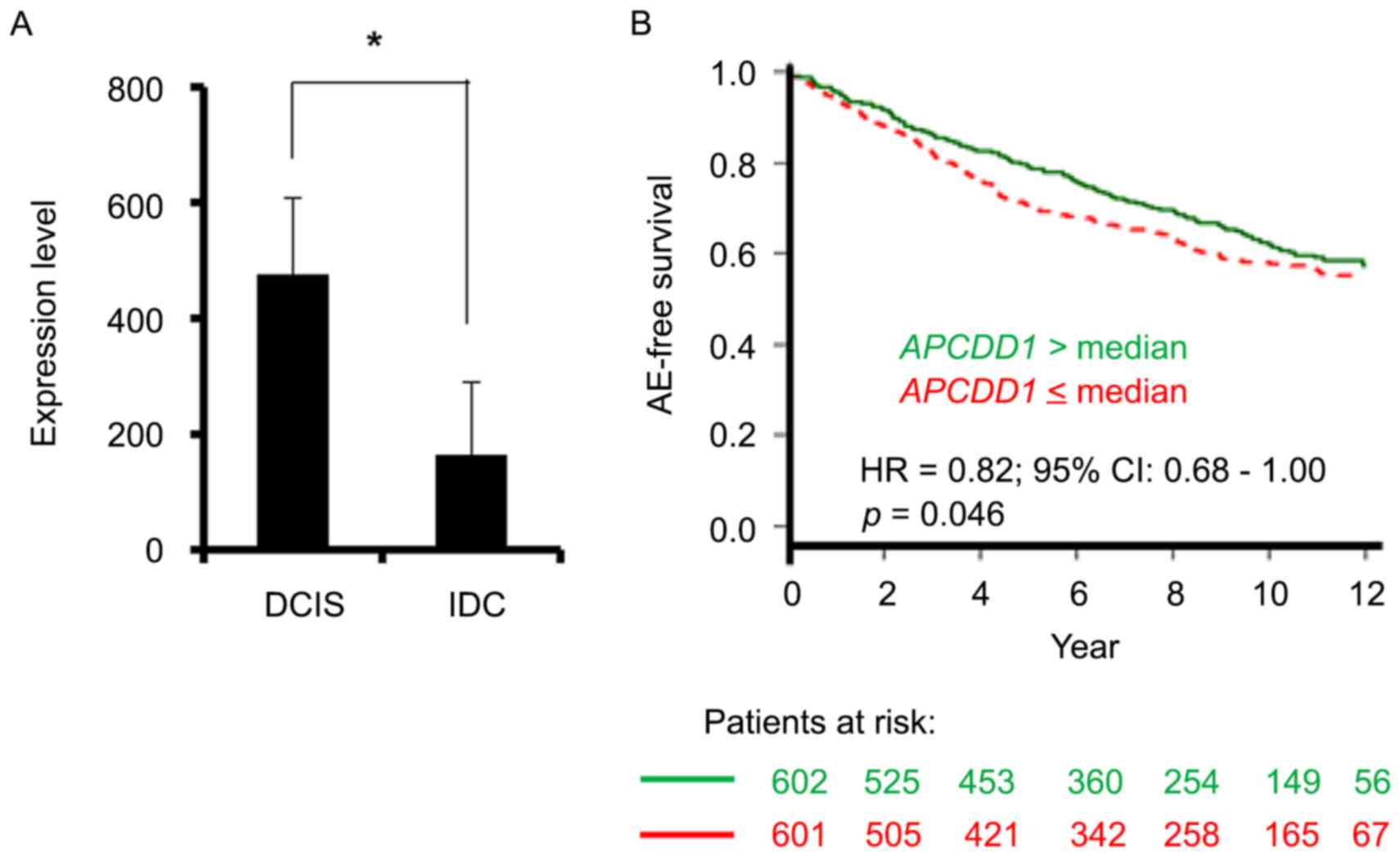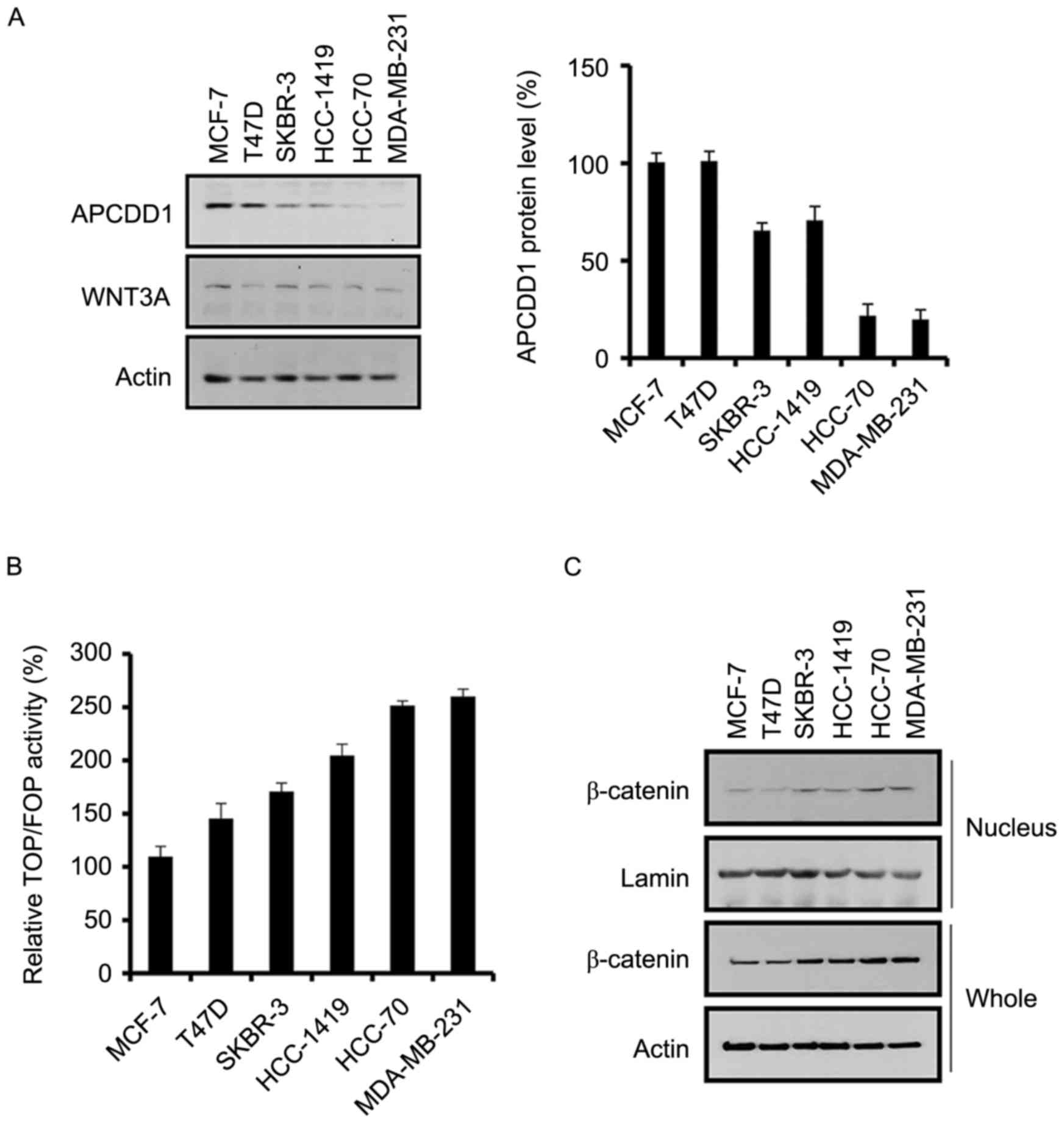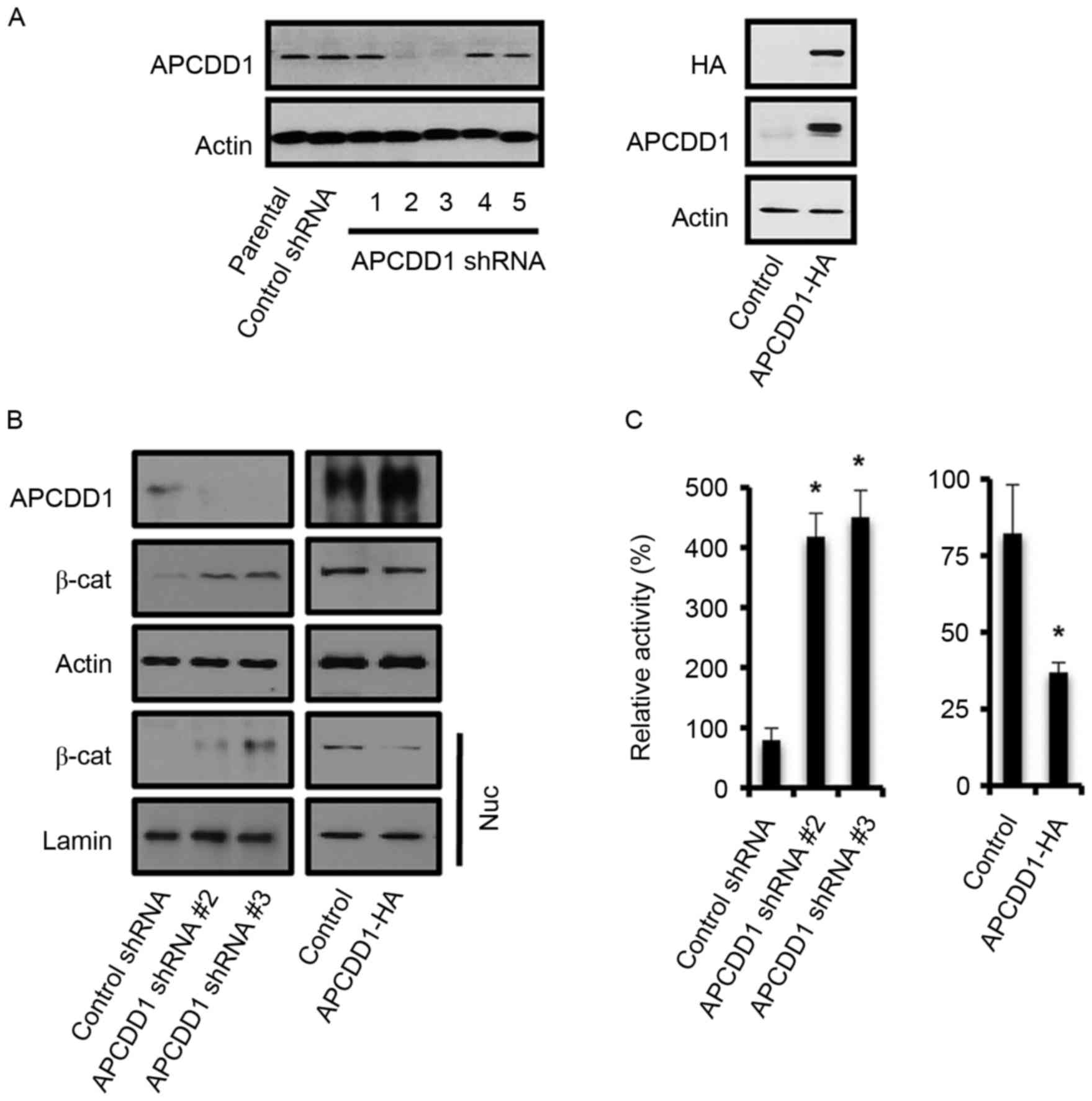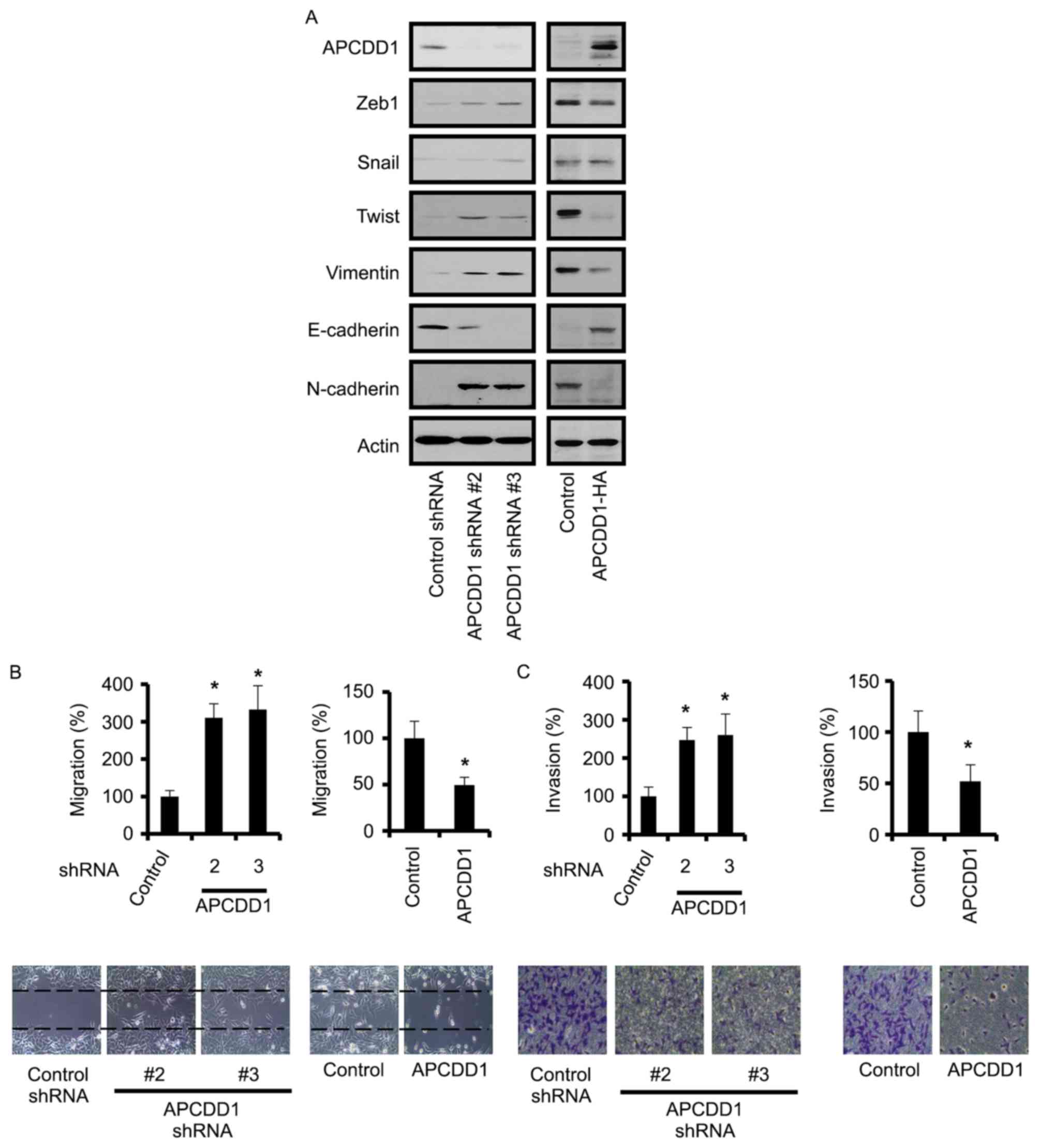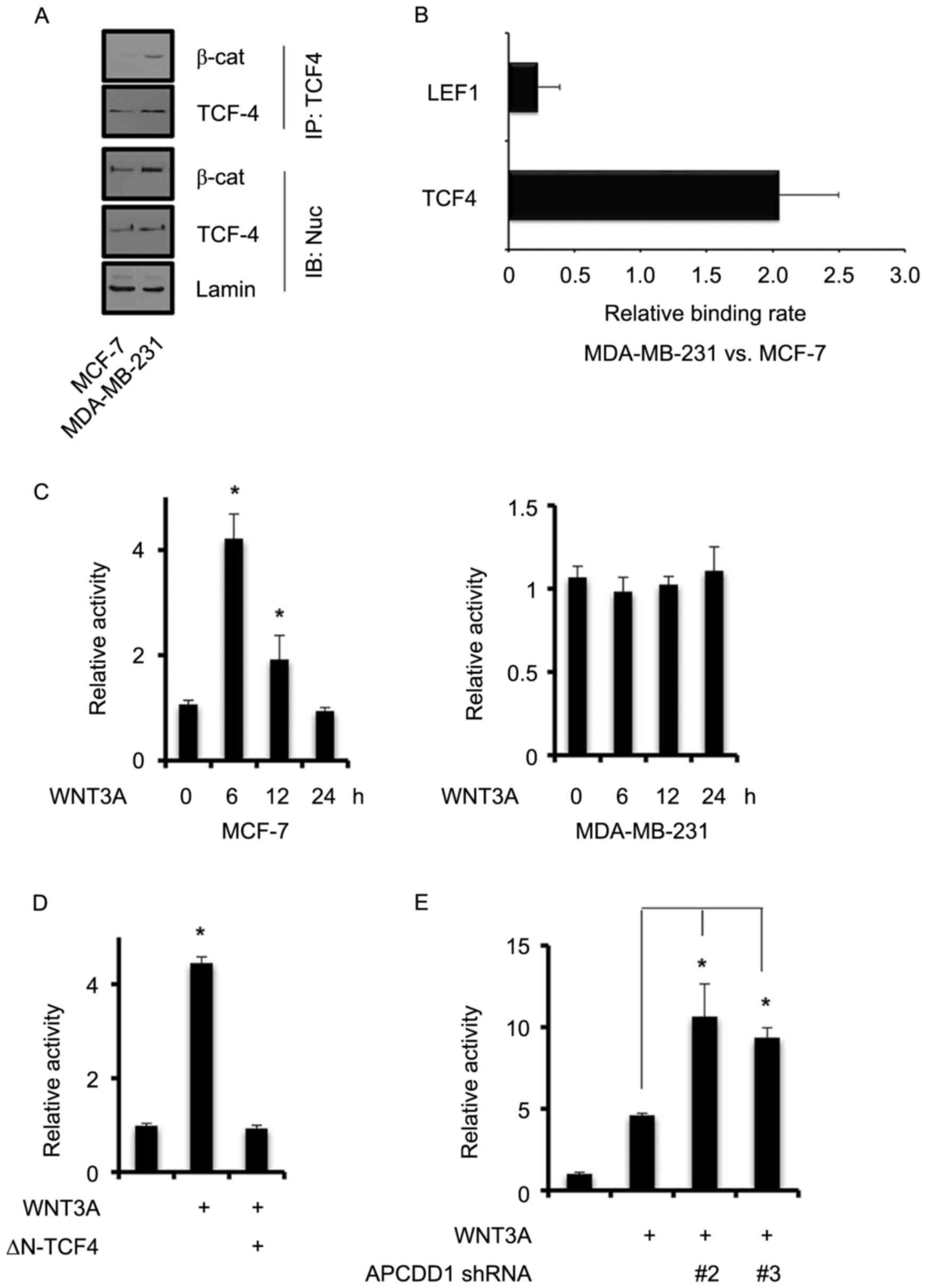APC downregulated 1 inhibits breast cancer cell invasion by inhibiting the canonical WNT signaling pathway
- Authors:
- Published online on: August 23, 2017 https://doi.org/10.3892/ol.2017.6801
- Pages: 4845-4852
Abstract
Introduction
The WNT signaling pathway is associated with numerous biological events, including embryonic development and adult tissue homeostasis. Therefore, abnormal WNT signaling is associated with diseases, including certain types of cancer (1,2). WNTs activate the canonical and non-canonical signaling pathways, which are mutually exclusive. The canonical WNT signaling pathway triggers β-catenin-dependent transcriptional regulation, whereas the non-canonical WNT signaling pathway activates the β-catenin-independent signaling pathway (1,2).
The canonical WNT signaling pathway regulates normal breast development, and its deregulation is associated with breast cancer progression (3,4). WNTs aid in the generation of the canonical WNT signaling pathway by binding to the coreceptors LDL receptor-related protein (LRP)5/6 and frizzled on the cell surface, and activating the β-catenin/t-cell factor (TCF) complex (2). Overexpression of Wnt1, which may be induced by the integration of the mouse mammary tumor virus, triggers mammary tumor development (5,6). Autocrine WNT signaling regulates mammary epithelial cell fate by regulating renewal and the epithelial-to-mesenchymal transition (EMT), thereby affecting tumorigenesis and metastasis in a deregulated signaling state (7,8). Accordingly, the WNT-activated β-catenin/TCF complex potentiates breast cancer metastasis by altering the expression of genes associated with EMT (9,10).
Previous studies have revealed multiple inhibitors of the canonical WNT signaling pathway, including secreted frizzled-related protein (SFRP), dickkopf (DKK), and WNT inhibitory factor (WIF) (2,11). In addition, APC downregulated 1 (APCDD1) may inhibit the canonical WNT signaling pathway by directly binding WNT3A and LRP5 on the cell surface (11,12). Therefore, APCDD1 represents an inhibitor of the canonical WNT signaling pathway. While a previous study demonstrated that APCDD1 promoted colorectal cancer growth, its function as the inhibitor of the canonical WNT signaling pathway was not assessed (13). Furthermore, its function in different types of cancer, including breast cancer, remains to be fully understood. The present study evaluated the function of APCDD1 in breast cancer cells and revealed that APCDD1 regulated breast cancer cell invasion.
Materials and methods
Cell culture, reagents and plasmids
The HEK-293T, non-invasive breast cancer MCF-7 and T-47D, invasive breast cancer SKBR3 and MDA-MB-231 cell lines were cultured in Dulbecco's modified Eagle's medium supplemented with 10% fetal bovine serum (FBS; Gibco; Thermo Fisher Scientific, Inc., Waltham, MA, USA) and 1% penicillin/streptomycin at 37°C in a humidified atmosphere of 5% CO2 and 95% air. Invasive breast cancer HCC-1419 and HCC-70 cell lines were cultured in RPMI-1640 medium (Gibco; Thermo Fisher Scientific, Inc.) supplemented with 10% FBS and 1% penicillin/streptomycin at 37°C in a humidified atmosphere of 5% CO2 and 95% air. A concentration of 1×106 MCF-7 or MDA-MB-231 cells were transfected with the appropriate plasmids for 24 h using Lipofectamine 2000 (Invitrogen; Thermo Fisher Scientific, Inc.), according to the manufacturer's protocol, and was cultured for another 24 h at 37°C. Recombinant human WNT3A (catalog no. 5036-GMP; recombinant human WNT3A GMP, carrier free) was purchased from R&D Systems, Inc. (Minneapolis, MN, USA). To assess the effect of WNT3A, MCF-7 and MDA-MB-231 cells were treated with 1 µg/ml recombinant human WNT3A. Cyclosporine A, FK506 and BAPTA-AM were obtained from Tocris Bioscience (Bristol, UK). EGTA-AM was purchased from EMD Millipore (Billerica, MA, USA). Lentiviral APCDD1 short hairpin (sh)RNAs [1, TRCN0000413419 (CCG GGA AAG CTA GGG CCT CTT ATT TCT CGA GAA ATA AGA GGC CCT AGC TTT CTT TTT TG); 2, TRCN0000136710 (CCG GGA GCT CTT CCT TGG TGA CAT TCT CGA GAA TGT CAC CAA GGA AGA GCT CTT TTT TG); 3, TRCN0000136596 (CCG GCG GTG CAC AAA TCC CAC TTA TCT CGA GAT AAG TGG GAT TTG TGC ACC GTT TTT TG); 4, TRCN0000137317 (CCG GGC CAG AGA ACT GTC CTT CTT TCT CGA GAA AGA AGG ACA GTT CTC TGG CTT TTT TG); and 5, TRCN0000136748 (CCG GGC TGG AAT CCA ATG CAG AGT TCT CGA GAA CTC TGC ATT GGA TTC CAG CTT TTT TG)] and control plasmids pLKO TRC005 (TRCN0000231701; target sequence TCA GTT CCA GTA CGG CTC CAA) and pLKO TRC001 (TRCN0000072208; target sequence GCT TCA AGT GGG AGC GCG TGA) were obtained from Sigma-Aldrich; Merck KGaA (Darmstadt, Germany). pMD2.G (12259; Addgene, Inc., Cambridge, MA, USA) and psPAX2 (12260; Addgene, Inc.) were used for lentiviral packaging. A full length HindIII/XhoI fragment of APCDD1 was inserted into a pCMV6-AC-HA plasmid (Origene Technologies, Inc., Rockville, MD, USA). For the APCDD1-luciferase (luc) plasmid, the APCDD1 promoter regions between −1,000 bp and +1 bp, −500 bp and +1 bp, and −200 bp and +1 bp were inserted into a pGL3-Basic vector (Promega Corporation, Madison, WI, USA). Wild-type β-catenin (β-catenin-WT; pcDNA3-β-catenin; Addgene ID, 16828), β-catenin-S33Y (pcDNA3-S33Y-β-catenin; Addgene ID, 19286), β-catenin shRNA (pLKO.1 puro shRNA β-catenin; Addgene ID, 18803), TCF4 mutant lacking β-catenin interaction domain (∆N-TCF4; pcDNA/MYC proto-oncogene-∆N-TCF4; Addgene ID, 16513) and TCF/lymphoid enhancer binding factor (LEF) reporter plasmids (M50 Super 8x TOPFlash, Addgene ID, 12456; M51 Super 8x FOPFlash, Addgene ID, 12457) were obtained from Addgene, Inc. (Cambridge, MA, USA). All experiments were performed at least three times.
Chromatin immunoprecipitation (ChIP) and luc assays
TCF4 binding sites at −1,000 bp upstream of the APCDD1 gene were analyzed in silico using the publicly available programs PROMO, LASAGNA and JASPAR (14–17). ChIP assays using a ChIP kit (Abcam, Cambridge, MA, USA) were performed according to the manufacturer's protocol. A concentration of 3×106 MCF-7 and MDA-MB-231 cells were subjected to the ChIP assays. As a negative control, rabbit IgG (Abcam) was used. Quantitative polymerase chain reaction (qPCR) was performed using SYBR Green real-time PCR master mix (cat no. 4309,155; Thermo Fisher Scientific, Inc.), according to the manufacturer's protocol. Samples were incubated for 10 min at 95°C, denatured for 15 sec at 95°C and annealed and extended for 1 min at 60°C, for 40 cycles. qPCR reactions were performed using a LightCycler 480 Instrument II (Roche Diagnostics, Indianapolis, IN, USA), and relative quantifications were automatically performed using LightCycler 480 software 1.5 (Roche Diagnostics). Primer sequences for ChiP assays were as follows: forward 5′-TTGGGTCTCAAACGCCCATG-3′, reverse 5′-TTCATATTTCCAGCGCGCGCC-3′. GAPDH was used as a positive control. Its primer sequences are as follows: Forward, 5′-CGGGATTGTCTGCCCTAATTAT-3′ and reverse, 5′-GCACGGAAGGTCACGATGT-3′ (18). The reporter plasmid pAPCDD1-luc was subjected to the luc assay. Luc assays were performed using a Dual-Luciferase Reporter Assay system (Promega, Madison, WI, USA). In brief, activities of firefly and Renilla luciferases were sequentially determined and firefly luciferase activity was divided by Renilla luciferase activity to obtain a fold activity. All experiments were performed in triplicate and independently repeated three times.
Western blot analysis and immunoprecipitation assays
Antibodies against actin (sc-47778; dilution, 1:200) and lamin (sc-6215; dilution, 1:200) were purchased from Santa Cruz Biotechnology, Inc. (Dallas, TX, USA). Antibodies against TCF4 (dilution, 1:1,000; 2569), β-catenin (dilution, 1:1,000; 8480), snail (dilution, 1:1,000; 3879), twist (dilution 1:1,000; 46702), vimentin (dilution, 1:1,000; 5741), epithelial (E) -cadherin (dilution, 1:1,000; 3195) and neural (N)-cadherin (dilution, 1:1,000; 13116) were purchased from Cell Signaling Technology, Inc. (Danvers, MA, USA). Antibodies against APCDD1 (dilution, 1:1,000; ab73063) and hemagglutinin (HA) were purchased from Abcam. Horseradish peroxidase-conjugated anti-rabbit IgG (#7074) or anti-mouse IgG (#7076) antibodies (Cell Signaling Technology, Inc.) were used as secondary antibodies at a dilution of 1:10,000. Nuclear fraction was achieved using a Cell Fractionation kit (Cell Signaling Technology, Inc.). Immunoprecipitation assays were performed using protein A/G Plus agarose beads (Santa Cruz Biotechnology, Inc.). For western blot analysis, 3×106 cells (all cell types analyzed in this study) were lyzed using radioimmunoprecipitation buffer for 30 min on ice and centrifuged at 20,000 × g for 10 min at 4°C. Evaluation of protein concentrations was performed using Pierce BCA protein assay kit (Pierce; Thermo Fisher Scientific, Inc.), according to the manufacture's protocol. A total of 30 µg protein/lane was loaded to 10–12% SDS-PAGE and transferred to a polyvinylidene difluoride membrane (GE Healthcare Life Sciences, Little Chalfont, UK). For the immunoprecipitation assays, 300 µg of nuclear protein from either MCF-7 or MDA-MB-231 cells, 10 µl protein A/G plus agarose solution (0.5 ml agarose/2.0 ml solution; Santa Cruz Biotechnology, Inc.) and 1 µg appropriate antibody were mixed and incubated for 12 h at 4°C. Subsequent to blocking with 5% milk for 1 h at room temperature, the membrane was incubated with the aforementioned antibodies for another 1 h at room temperature. Actin was detected as an internal control. The membranes were then incubated with the aforementioned secondary antibodies for 1 h at room temperature. Western bands were detected using LumiGLO chemiluminescent reagent and peroxidase (#7003; Cell Signaling Technology Inc.). Western blot analyses were performed independently three times. ImageJ software (version 1.50) was used for relative quantifications (National Institutes of Health, Bethesda, MA, USA).
Cell proliferation, migration and invasion assays
A concentration of 3×105 APCDD1-overexpressing or APCDD1-silenced cells together with the control cells were separately cultured in 6-well plates for 72 h at 37°C, and cell numbers were counted every day. Experiments were performed in quadruplicate and independently repeated in triplicate. For cell migration, 3×105 APCDD1-overexpressing or APCDD1-silenced cells together with the control cells were cultured in 6-well plates and scratched at 37°C when the confluence reached ~80%, and then the number of migrated cells was counted 24 h after scratching. Experiments were performed in triplicate. For the invasion assays, 3×105 APCDD1-overexpressing or APCDD1-silenced cells together with the control cells were cultured in the upper chambers of Matrigel-pre-coated Transwell plates and incubated for 16 h at 37°C. The cells in the upper chamber were removed using a swab and the cells that had invaded through the Matrigel were stained with 0.4% crystal violet for 10 min at room temperature, washed with water and then counted. Experiments were performed in triplicate. The cell migration and invasions were determined using a Zeizz Axiovert inverted microscope, and the images were analyzed using Zen software version 3.00 (Carl Zeizz, Oberkochen, Germany). A total of 4 fields were randomly selected and the migrated or invaded cells were counted.
Data mining from gene expression dataset
From the Gene Expression Omnibus (GEO) datasets in NCBI (https://www.ncbi.nlm.nih.gov/geo/), GSE21422 series was chosen as it featured gene expression profiles of human ductal carcinoma in situ (DCIS) and invasive ductal breast carcinoma (IDC). APCDD1 expression levels in DCIS and IDC were then analyzed using data analysis tools for GDS3853 in dataset browser. Any event (AE)-free event plot with APCDD1 expression pattern was obtained from the website, Breast Cancer Gene-Expression Miner v4.0 (http://bcgenex.centregauducheau.fr).
Statistical analysis
Unpaired Student's t-test or one-way analysis of variance with a post-hoc Tukey's test was performed to calculate the statistical significance of the results of the present study. Results were presented as the mean ± standard deviation and P<0.05 was considered to indicate a statistically significant difference. Calculations were performed using SPSS version 22 (IBM Corp., Armonk, NY, USA) software.
Results
APCDD1 expression pattern in breast cancer
The Gene Expression Omnibus GSE21422 dataset (19,20) revealed that the level of APCDD1 transcript was significantly increased in ductal carcinoma in situ (DCIS) compared with that in invasive ductal carcinoma (IDC) (Fig. 1A). Furthermore, the GSE1456 and GSE10510 datasets on patients with breast cancer (20–22) demonstrated that increased APCDD1 expression was associated with a favorable prognosis in terms of any event-free survival (Fig. 1B). These datasets suggested that APCDD1 may negatively regulate breast cancer progression.
APCDD1 expression pattern in breast cancer cell lines
The expression patterns of APCDD1 in multiple breast cancer cell lines were assessed. Although WNT3A expression did not differ between the breast cancer cell lines, APCDD1 expression was increased in non-invasive compared with invasive breast cancer cells (Fig. 2A). This result was consistent with data where APCDD1 expression was decreased in IDC compared with that in DCIS (Fig. 1A).
As APCDD1 inhibits the canonical WNT signaling pathway (12), TCF/LEF transcription was assessed in the breast cancer cells. TCF/LEF transcription was positively associated with the invasive ability of the breast cancer cells (Fig. 2B), suggesting a negative association between TCF/LEF transcription and APCDD1 expression.
Since β-catenin is crucial for TCF/LEF transcription (23,24), β-catenin expression in the breast cancer cells was assessed. The invasive breast cancer cells exhibited increased expression of nuclear and total β-catenin compared with that exhibited by the non-invasive breast cancer cells (Fig. 2C). Therefore, the results of the present study demonstrated that the canonical WNT signaling pathway is positively associated with invasion in breast cancer cells, which suggests that APCDD1 may regulate breast cancer cell invasion, as driven by the canonical WNT signaling pathway.
APCDD1 function in the canonical WNT signaling pathway in breast cancer cells
Since APCDD1 expression was associated with the invasive phenotype of breast cancer cells, the function of APCDD1 in the invasion of breast cancer cells was assessed. Constructs 2 and 3 of the lentiviral APCDD1 shRNA plasmids repressed APCDD1 expression in MCF-7 cells (Fig. 3A). Hemagglutinin (HA)-tagged APCDD1 was overexpressed in MDA-MB-231 cells and detected using an antibody for either HA or APCDD1 (Fig. 3A). Altered APCDD1 expression negatively affected nuclear β-catenin expression (Fig. 3B) and TCF/LEF functions (Fig. 3C).
APCDD1 function in breast cancer cell metastasis
Since the canonical WNT signaling pathway regulates the expression of EMT-associated genes and promotes invasion in breast cancer cells (9), the present study assessed whether altering APCDD1 expression in breast cancer cells affects the expression patterns of EMT-associated genes. Silencing APCDD1 in MCF-7 cells or inducing APCDD1 overexpression in MDA-MB-231 cells altered the expression of EMT-associated genes, including zinc finger E-box binding homeobox 1 (Zeb1), Twist, Vimentin, E-cadherin and N-cadherin, while altering APCDD1 expression did not affect snail expression (Fig. 4A). APCDD1 silencing increased the expression levels of Zeb1, Twist, Vimentin and N-cadherin and reduced E-cadherin expression level. APCDD1 overexpression reversed expression patterns of those proteins.
Furthermore, silencing APCDD1 in MCF-7 cells promoted migration and invasion, and its overexpression in MDA-MB-231 cells attenuated migration and invasion (Fig. 4B and C). However, altering APCDD1 expression did not significantly affect growth in these cell lines (data not shown). Therefore, these results suggested that APCDD1 inhibited the invasion of the breast cancer cells.
Canonical WNT signaling pathway regulates APCDD1 expression via the TCF4/β-catenin complex
Since β-catenin is crucial for TCF4 transcription (23–25), β-catenin interaction with TCF4 in the breast cancer cells was further assessed. The interaction rate between β-catenin and TCF4 was increased in highly invasive MDA-MB-231 cells compared with that in less invasive MCF-7 cells (Fig. 5A). Subsequently, TCF4 interaction with APCDD1 promoter regions was evaluated in MCF-7 and MDA-MB-231 breast cancer cell lines using ChIP assays with anti-TCF4 antibodies. The interaction rate of TCF4 with APCDD1 promoter regions was increased in MDA-MB-231 cells compared with that in MCF-7 cells (Fig. 5B). Therefore, the results of the present study suggested that the canonical WNT signaling pathway was more active in the invasive than in the non-invasive breast cancer cells.
The results of the present study revealed that APCDD1 expression was negatively associated with TCF4/β-catenin activity. Therefore, the present study assessed how the β-catenin/TCF4 complex regulates APCDD1 promoter activity. In MCF-7 cells, the recombinant human WNT3A significantly increased APCDD1 promoter activity 6 h after treatment, but reduced it again 12 h after treatment (Fig. 5C). However, WNT3A did not significantly increase APCDD1 promoter activity in MDA-MB-231 cells at any time after treatment (Fig. 5C).
The present study found that, following the transfection of MCF-7 cells with ∆N-TCF4 and treatment with WNT3A for 6 h, APCDD1 promoter activity was not altered as compared with the control (Fig. 5D), indicating that WNT3A requires TCF4 for APCDD1 promoter activation.
The present study demonstrated that the canonical WNT signaling pathway positively regulated APCDD1 expression in the non-invasive breast cancer cells, whereas the activity of the canonical WNT signaling pathway was negatively associated with APCDD1 expression. Therefore, this suggested that APCDD1 repressed the induction of APCDD1 expression by WNT3A through a negative feedback mechanism. Silencing APCDD1 in MCF-7 cells using lentiviral APCDD1 shRNA and subsequently treating the cells with WNT3A for 12 h increased APCDD1 promoter activity (Fig. 5E). Therefore, the results of the present study indicated that the canonical WNT signaling pathway in the non-invasive breast cancer cells generated APCDD1-mediated negative feedback signaling.
Discussion
The canonical WNT signaling pathway is crucial for breast cancer progression, including distant metastasis (1,2,4,6). APCDD1 represents an inhibitor of the canonical WNT signaling pathway (12). Although APCDD1 has been revealed to promote colorectal cancer cell proliferation (13), its functions in other types of cancer are yet to be fully understood. The present study demonstrated that APCDD1 suppressed the canonical WNT signaling pathway-driven invasion of breast cancer cells.
APCDD1 expression was decreased in the invasive compared with the non-invasive breast cancer cells. Furthermore, the results of the present study suggested that APCDD1, via its inhibitory function in the canonical WNT signaling pathway, suppressed the invasion of the breast cancer cells. When considering autocrine WNT signaling in breast cancer cells (8), APCDD1 may determine an input level of autocrine WNT signaling and thereby facilitate invasion.
The results of the present study demonstrated that the β-catenin/TCF4 complex regulated APCDD1 expression in the breast cancer cells, which is consistent with the results of a previous study that demonstrated that the β-catenin/TCF4 complex positively regulated APCDD1 expression in colorectal cancer cells (13). However, APCDD1 functioned as a negative regulator of the canonical WNT signaling pathway in the breast cancer cells of the present study, which is consistent with a previous study that revealed that APCDD1 binds to WNT3A and LRP5 to inhibit the canonical WNT signaling pathway in hair follicles (12). Although APCDD1 has been demonstrated to promote colorectal cancer cell proliferation (13), in the present study it suppressed breast cancer cell invasion without affecting proliferation. Therefore, APCDD1 may balance the canonical WNT signaling pathway via the autocrine signaling pathway. However, the mechanisms that repress APCDD1 expression to potentiate the canonical WNT signaling pathway, which is crucial for invasion, since invasion depends on the altered expression of EMT-associated genes, is yet to be fully understood.
Inhibitors of WNT signaling pathways, including WIF, DKK and SFRP, have been demonstrated to repress breast cancer development and metastasis (11,26,27). However, the manner in which WNT signaling pathways and their inhibitors function together during cancer progression remains unclear. Whereas APCDD1 expression is negatively associated with invasion, WIF, DKK and SFRP are epigenetically inactivated in breast cancer cells, independent of invasion (28,29). Therefore, different WNT signaling pathway inhibitors may serve crucial functions in the multiple roles of the canonical WNT signaling pathway in breast cancer progression. In conclusion, inhibitors against WNT signaling pathway are numerous and their functions overlap. Thus, future research should investigate the specific roles of each inhibitor, which will be useful to design drugs and treatment schedules for breast cancer.
Acknowledgements
The present study was supported by the Korea National University of Transportation in 2016 and by the Basic Science Research Program through the National Research Foundation of Korea funded by the Ministry of Science, ICT and Future Planning (grant no. NRF-2014R1A1A1035831).
References
|
Clevers H and Nusse R: Wnt/β-catenin signaling and disease. Cell. 149:1192–1205. 2012. View Article : Google Scholar : PubMed/NCBI | |
|
Anastas JN and Moon RT: WNT signalling pathways as therapeutic targets in cancer. Nat Rev Cancer. 13:11–26. 2013. View Article : Google Scholar : PubMed/NCBI | |
|
Incassati A, Chandramouli A, Eelkema R and Cowin P: Key signaling nodes in mammary gland development and cancer:β-catenin. Breast Cancer Res. 12:2132010. View Article : Google Scholar : PubMed/NCBI | |
|
Smalley MJ and Dale TC: Wnt signalling in mammalian development and cancer. Cancer Metastasis Rev. 18:215–230. 1999. View Article : Google Scholar : PubMed/NCBI | |
|
Nusse R and Varmus HE: Many tumors induced by the mouse mammary tumor virus contain a provirus integrated in the same region of the host genome. Cell. 31:99–109. 1982. View Article : Google Scholar : PubMed/NCBI | |
|
Li Y, Hively WP and Varmus HE: Use of MMTV-Wnt-1 transgenic mice for studying the genetic basis of breast cancer. Oncogene. 19:1002–1009. 2000. View Article : Google Scholar : PubMed/NCBI | |
|
Scheel C, Eaton EN, Li SH, Chaffer CL, Reinhardt F, Kah KJ, Bell G, Guo W, Rubin J, Richardson AL and Weinberg RA: Paracrine and autocrine signals induce and maintain mesenchymal and stem cell states in the breast. Cell. 145:926–940. 2011. View Article : Google Scholar : PubMed/NCBI | |
|
Bafico A, Liu G, Goldin L, Harris V and Aaronson SA: An autocrine mechanism for constitutive Wnt pathway activation in human cancer cells. Cancer Cell. 6:497–506. 2004. View Article : Google Scholar : PubMed/NCBI | |
|
Yook JI, Li XY, Ota I, Hu C, Kim HS, Kim NH, Cha SY, Ryu JK, Choi YJ, Kim J, et al: A Wnt-Axin2-GSK3beta cascade regulates Snail1 activity in breast cancer cells. Nat Cell Biol. 8:1398–1406. 2006. View Article : Google Scholar : PubMed/NCBI | |
|
Wu ZQ, Li XY, Hu CY, Ford M, Kleer CG and Weiss SJ: Canonical Wnt signaling regulates Slug activity and links epithelial-mesenchymal transition with epigenetic breast cancer 1, early onset (BRCA1) repression. P Natl Acad Sci USA. 109:16654–16659. 2012. View Article : Google Scholar | |
|
Cruciat CM and Niehrs C: Secreted and transmembrane wnt inhibitors and activators. Cold Spring Harb Perspect Biol. 5:a0150812013. View Article : Google Scholar : PubMed/NCBI | |
|
Shimomura Y, Agalliu D, Vonica A, Luria V, Wajid M, Baumer A, Belli S, Petukhova L, Schinzel A, Brivanlou AH, et al: APCDD1 is a novel Wnt inhibitor mutated in hereditary hypotrichosis simplex. Nature. 464:1043–1047. 2010. View Article : Google Scholar : PubMed/NCBI | |
|
Takahashi M, Fujita M, Furukawa Y, Hamamoto R, Shimokawa T, Miwa N, Ogawa M and Nakamura Y: Isolation of a novel human gene, APCDD1, as a direct target of the beta-Catenin/T-cell factor 4 complex with probable involvement in colorectal carcinogenesis. Cancer Res. 62:5651–5656. 2002.PubMed/NCBI | |
|
Mathelier A, Zhao X, Zhang AW, Parcy F, Worsley-Hunt R, Arenillas DJ, Buchman S, Chen CY, Chou A, Ienasescu H, et al: JASPAR 2014: An extensively expanded and updated open-access database of transcription factor binding profiles. Nucleic Acids Res. 42:(Database issue). D142–D147. 2014. View Article : Google Scholar : PubMed/NCBI | |
|
Messeguer X, Escudero R, Farré D, Núñez O, Martinez J and Albà MM: PROMO: Detection of known transcription regulatory elements using species-tailored searches. Bioinformatics. 18:333–334. 2002. View Article : Google Scholar : PubMed/NCBI | |
|
Farré D, Roset R, Huerta M, Adsuara JE, Roselló L, Albà MM and Messeguer X: Identification of patterns in biological sequences at the ALGGEN server: PROMO and MALGEN. Nucleic Acids Res. 31:3651–3653. 2003. View Article : Google Scholar : PubMed/NCBI | |
|
Lee C and Huang CH: LASAGNA-Search: An integrated web tool for transcription factor binding site search and visualization. Biotechniques. 54:141–153. 2013. View Article : Google Scholar : PubMed/NCBI | |
|
Livak KJ and Schmittgen TD: Analysis of relative gene expression data using real-time quantitative PCR and the 2(−Delta Delta C(T)) method. Methods. 25:402–408. 2001. View Article : Google Scholar : PubMed/NCBI | |
|
Kretschmer C, Sterner-Kock A, Siedentopf F, Schoenegg W, Schlag PM and Kemmner W: Identification of early molecular markers for breast cancer. Mol Cancer. 10:152011. View Article : Google Scholar : PubMed/NCBI | |
|
Edgar R, Domrachev M and Lash AE: Gene expression omnibus: NCBI gene expression and hybridization array data repository. Nucleic Acids Res. 30:207–210. 2002. View Article : Google Scholar : PubMed/NCBI | |
|
Pawitan Y, Bjöhle J, Amler L, Borg AL, Egyhazi S, Hall P, Han X, Holmberg L, Huang F, Klaar S, et al: Gene expression profiling spares early breast cancer patients from adjuvant therapy: Derived and validated in two population-based cohorts. Breast Cancer Res. 7:R953–R964. 2005. View Article : Google Scholar : PubMed/NCBI | |
|
Calabrò A, Beissbarth T, Kuner R, Stojanov M, Benner A, Asslaber M, Ploner F, Zatloukal K, Samonigg H, Poustka A and Sültmann H: Effects of infiltrating lymphocytes and estrogen receptor on gene expression and prognosis in breast cancer. Breast Cancer Res Treat. 116:69–77. 2009. View Article : Google Scholar : PubMed/NCBI | |
|
Graham TA, Ferkey DM, Mao F, Kimelman D and Xu W: Tcf4 can specifically recognize beta-catenin using alternative conformations. Nat Struct Biol. 8:1048–1052. 2001. View Article : Google Scholar : PubMed/NCBI | |
|
Morin PJ, Sparks AB, Korinek V, Barker N, Clevers H, Vogelstein B and Kinzler KW: Activation of beta-catenin-Tcf signaling in colon cancer by mutations in beta-catenin or APC. Science. 275:1787–1790. 1997. View Article : Google Scholar : PubMed/NCBI | |
|
Poy F, Lepourcelet M, Shivdasani RA and Eck MJ: Structure of a human Tcf4-beta-catenin complex. Nat Struct Biol. 8:1053–1057. 2001. View Article : Google Scholar : PubMed/NCBI | |
|
Matsuda Y, Schlange T, Oakeley EJ, Boulay A and Hynes NE: WNT signaling enhances breast cancer cell motility and blockade of the WNT pathway by sFRP1 suppresses MDA-MB-231 xenograft growth. Breast Cancer Res. 11:R322009. View Article : Google Scholar : PubMed/NCBI | |
|
Mikheev AM, Mikheeva SA, Maxwell JP, Rivo JV, Rostomily R, Swisshelm K and Zarbl H: Dickkopf-1 mediated tumor suppression in human breast carcinoma cells. Breast Cancer Res Treat. 112:263–273. 2008. View Article : Google Scholar : PubMed/NCBI | |
|
Trifa F, Karray-Chouayekh S, Jmal E, Jmaa ZB, Khabir A, Sellami-Boudawara T, Frikha M, Daoud J and Mokdad-Gargouri R: Loss of WIF-1 and Wnt5a expression is related to aggressiveness of sporadic breast cancer in Tunisian patients. Tumor Biol. 34:1625–1633. 2013. View Article : Google Scholar | |
|
Suzuki H, Toyota M, Caraway H, Gabrielson E, Ohmura T, Fujikane T, Nishikawa N, Sogabe Y, Nojima M, Sonoda T, et al: Frequent epigenetic inactivation of Wnt antagonist genes in breast cancer. Br J Cancer. 98:1147–1156. 2008. View Article : Google Scholar : PubMed/NCBI |



